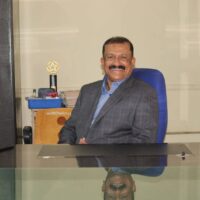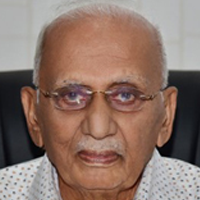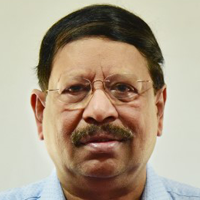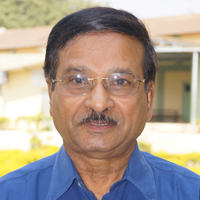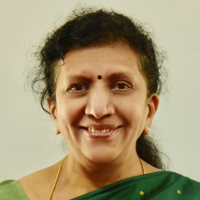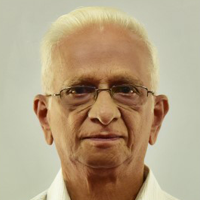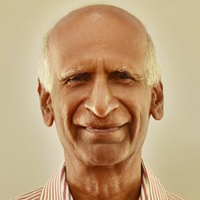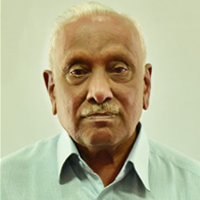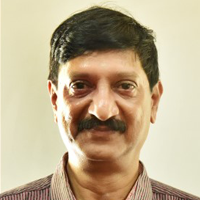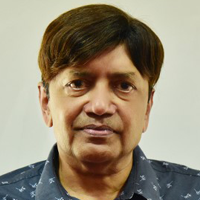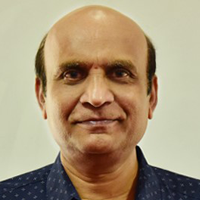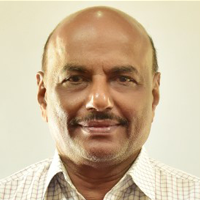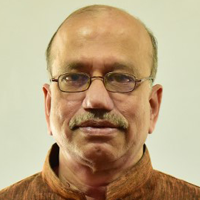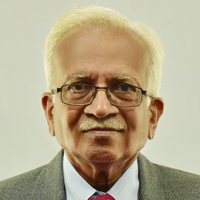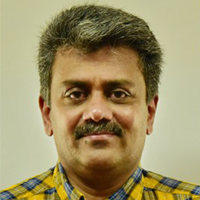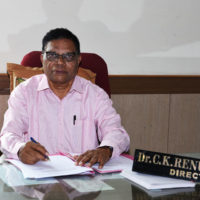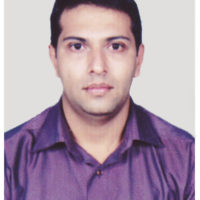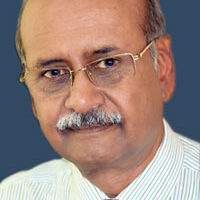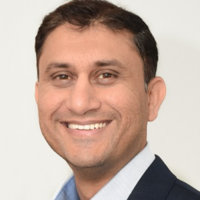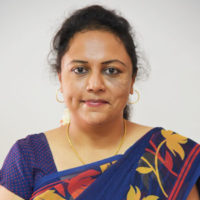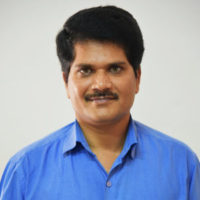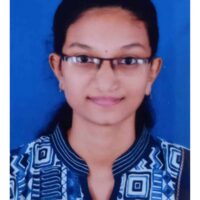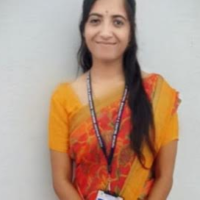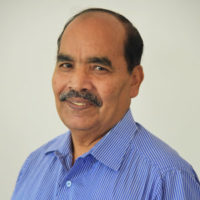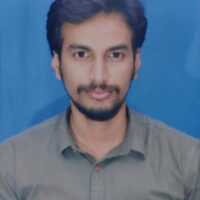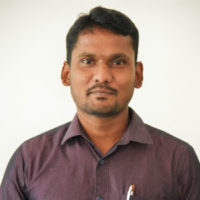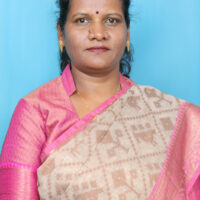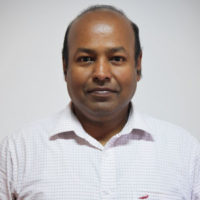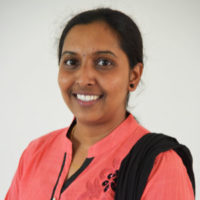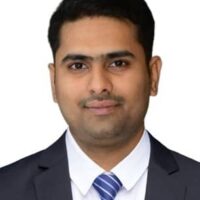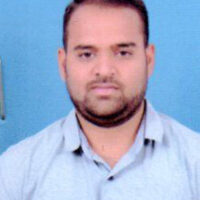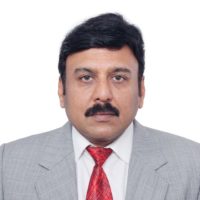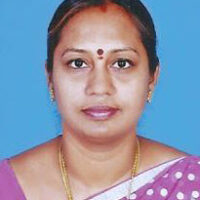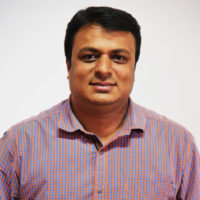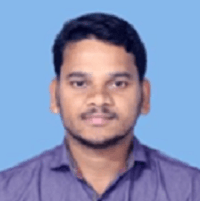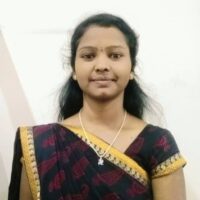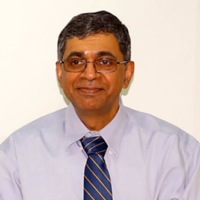
Dr. Srinivas Kumar
Education/Training
| INSTITUTION AND LOCATION | FIELD OF STUDY | DEGREE | COMPLETION DATE |
| Mysore Medical College, Mysore India | Medicine | M.B.B.S. | 3/1981 |
| J.I.P.M.E.R, Puducherry, India | Clinical Microbiology | M.D. | 3/1984 |
| SUNY at Buffalo, Buffalo, NY | Microbiology | Ph.D | 2/1991 |
|
Post-Doctoral Training at Univ. of Virginia, Charloteesville, VA |
HIV-1 Mol. Virology | 1991-1996 |
Positions
| Lecturer, Department of Microbiology, Kidwai Institute of Oncology, Bangalore, India | 10/84 – 08/85 |
| Graduate student with Dr. Thomas D. Flanagan, Department of Microbiology, State University of New York at Buffalo, Buffalo, New York | 08/85 – 02/91 |
| Research Scientist, Divison of Infectious Diseases, Children’s Hospital of Buffalo, Buffalo, New York | 02/90 – 02/91 |
|
Post-doctoral Research Associate, Myles H Thaler Center for AIDS and Human Retrovirus Research, Department of Microbiology, University of Virginia, Charlottesville, Virginia, USA. |
02/91 – 05/96 |
| Assistant Scientist, Bone Marrow Transplant, Department of Medicine, University of Wisconsin, Madison, Wisconsin, USA. |
08/96 – 09/99 |
| Research Assistant Professor, Division of Hematology/Oncology, Dept of Medicine, Vanderbilt University, Nashville, Tennessee, USA. |
09/99 – 06/11 |
| Research Associate Professor, Division of Hematology-Oncology, Department of Internal Medicine, Saint Louis University, St. Louis, Missouri, USA. |
07/11 -06/18 |
| Ernest Witebsky Memorial Award for proficiency in Microbiology, Department of Microbiology, SUNY at Buffalo, Buffalo, NY |
1996 |
| American Foundation for AIDS Research (AmFAR) Scholar Award |
07/93 – 08/96 |
Honors/Awards
| NIH AIDS Discovery & Development of Therapeutics Study Section | Regular Member | 2007-2011 |
| NIH Special Emphasis Panel to review ADDT member conflicts | ad hoc Committee Member | 2007 |
| NIH AIDS Discovery & Development of Therapeutics Study Section | ad hoc Committee Member | 2003 |
| NIH CSR Special Emphasis Panel, ZRG1 AARR-3 | ad hoc Committee Member | 2003 |
| Human Gene Transfer Advisory Group, Vanderbilt University | Member | 2003-2011 |
| Vanderbilt Institutional Biosafety Committee | Member | 2007-2011 |
| Research Planning Committee, Internal Study Section, School of Medicine, Saint Louis University | Extramural Proposal Reviews | 2012- Present |
| Molecular Therapy, Aids Research and Therapy, Retrovirology | Manuscript Reviews | ad hoc |
| Golden Jubilee International Conference of Indian Pharmacological Society, Southern Region, Mahatma Gandhi Medical College and Research Institute, Puducherry, India. July 4-5, 2017 | Session Chair | 2017 |
Contributions to Science
Entry of Sendai and respiratory syncytial viruses into cells
Elucidated principal mode of entry of respiratory syncytial virus is by the fusion of virus with plasma membrane of the target cell. Found that fusion of the Sendai virus with the target cell is inhibited by anionic polymers by binding to virus surface glycoproteins.
- Ohki S, Arnold K, Srinivasakumar N and Flanagan TD (1991). Effect of dextran sulfate on fusion of Sendai virus with human erythrocyte ghosts. Biomed Biochim. Acta 50:199-206. PMID: 1652245
- Srinivasakumar N, Ogra PL and Flanagan TD (1991). Characteristics of fusion of respiratory syncytial virus with HEp-2 cells as determined by the R18 dequenching assay. J Virol 65:4063-4069. PMCID: PMC248838
- Ohki S, Arnold K, Srinivasakumar N, and Flanagan TD (1992). Effect of anionic polymers on fusion of Sendai virus with human erythrocyte ghosts. Antivrial Res 18;163-177. PMID: 1329648
Protein interactions during HIV-1 assembly
Identified Major Homology Region (MHR) in the capsid region of HIV-1 Pr160GagPol precursor polyprotein as essential for its interaction with Pr55Gag polyprotein for recruitment into HIV-1 virus-like particles.
- Smith AJ, Srinivasakumar N, Hammarskj`ld M-L and Rekosh D (1993). Requirements for incorporation of Pr160gagpol from human immunodeficiency virus type I into virus-like particles. J Virol 67:2266-2275. PMCID: PMC240363
- Srinivasakumar N, Hammarskjold M-L, and Rekosh D (1995). Characterization of deletion mutations in the capsid region of HIV-1 that affect particle formation and gag-pol incorporation. J Virol 69:6106-6114. PMCID: PMC189507
Lentivirus vectors and packaging systems
Demonstrated that expression of virion Gag/GagPol core proteins as well as the gene transfer vector RNA in HIV-1 based packaging system requires Rev Response Element (RRE) in cis and the coexpression of Rev protein in trans. Described first stable HIV-1 based packaging cell line with significant titers and first Rev-independent HIV-1 packaging cell line using the Constitutive Transport Element (CTE) from Mason-Pfizer monkey virus.
Described HIV-1 packaging systems with reduced chance of reconstitution of a replication competent HIV during vector production by using alternative RNA transport element for expression of helper and gene transfer vector encoded RNAs. Showed that RNA transport elements from simian immunodeficiency virus or Mason-Pfizer monkey virus, singly or in combination can overcome inhibitory effect of an anti-HIV-1 transgene RevM10.
Reported HIV-1 vectors with novel safety attributes such as using the whimsical “jumping” ability of HIV-1 reverse transcriptase to eliminate the RRE during transduction of target cells. Described single-exon Tat encoding vectors that achieve ridiculously high levels of transgene expression in target cells. Demonstrated efficient transduction of hematopoietic progenitors after a single overnight exposure of freshly isolated bone marrow MNC to HIV-1 vector-containing supernatant in vitro in the absence of cytokine prestimulation (canine model).
- Srinivasakumar N, Chazal N, Helga-Maria C, Prasad S, Hammarskjold M-L, and Rekosh D (1997). The effect of viral regulatory protein expression on gene delivery using human immunodeficiency virus type I vectors produced in stable packaging cell lines. J Virol 71:5841-5848. PMCID: PMC191839
- Srinivasakumar N and Schuening FG (1999). A lentiviral packaging system based on alternative RNA transport mechanisms to express helper and gene transfer vector RNAs and its use to study the requirement of accessory proteins for particle formation and gene delivery. J Virol 73:9589-9598. PMCID: PMC112994
- Srinivasakumar N and Schuening FG (2000). Novel Tat encoding bicistronic human immunodeficiency virus type 1-based gene-transfer vectors for high-level transgene expression. J Virol 74:6659-6668. PMCID: PMC112178
- Srinivasakumar N, M. Zaboikin, T. Zaboikina, and Schuening FG (2002). Evaluation of Tat-encoding bicistronic HIV-1 gene transfer vectors in primary canine marrow mononuclear cells. (2002). J. Virology 76: 7334-7342. PMCID: PMCID: PMC136335
- Zaboikin M, Srinivasakumar N, Zaboikina T, and Schuening F (2004). Cloning and expression of canine O6-methylguanine-DNA methyltransferase in target cells, using gammaretroviral and lentiviral vectors. Hum Gene Ther. 15:383-392. PMID: 15053863
- Zaboikin M, Srinivasakumar N, Schuening F. (2006). Gene therapy with drug resistance genes.
Cancer Gene Ther. Apr;13(4):335-45. PMID: 16211086 - Srinivasakumar, N (2008). Substitution of the Rev-response element in an HIV-1-based gene delivery system with that of SIVmac239 allows efficient delivery of Rev M10 into T-lymphocytes. AIDS Res Ther 5:11 PMCID: PMC2438438
- Srinivasakumar N (2011). Rev-Free HIV-1 Gene Delivery System for Targeting Rev-RRE-Crm1 Nucleocytoplasmic RNA Transport Pathway. PLoS ONE 6(12): e28462. doi:10.1371/journal.pone.0028462. PMCID: PMC3229575
- Srinivasakumar N (2013). RRE-deleting self-inactivating and self-activating HIV-1 vector for improved safety. PeerJ 1:e84 http://dx.doi.org/10.7717/peerj.84. PMCID: PMC3678115
Induced pluripotent stem cells and genome-editing
Showed that successful reprogramming of cells into iPS cells is synonymous with silencing of retroviral promoter driven expression of reprogramming factors (or a marker gene). In that paper described an elegant methylation-sensitive restriction enzyme qPCR (MSRE-qPCR) assay to detect silencing of viral promoter by methylation at CpG residues. Described methods to accurately measure the genome editing efficiencies of the sequence-directed endonucleases.
- Zaboikin M, Freter C, Srinivasakumar N (2017). Gaussian decomposition of high-resolution melt curve derivatives for measuring genome editing efficiency (in preparation for posting on the preprint server: http://biorxiv.org before submission to peer-review journals)
- Zaboikin M, Zaboikina T, Freter C, Srinivasakumar N (2017). Non-Homologous End Joining and Homology Directed DNA Repair Frequency of Double-Stranded Breaks Introduced by Genome Editing Reagents. PLoS ONE 12(1): e0169931. doi:10.1371/journal.pone.0169931
- Zaboikin, M., Zaboikina, T., Freter, C. E., & Srinivasakumar, N. (2016). Differentiation of Genome Edited Human iPSCs into Endothelial Progenitor Cells for Hemophilia Α Therapy. Blood, 128(22), 1474–1474. (ASH Meeting Abstract)
- Srinivasakumar N, Zaboikin M, Tidball AM, Aboud AA, Neely MD, Ess KC, Bowman AB, and Schuening FG (2013). Gammaretroviral vector encoding a fluorescent marker to facilitate detection of reprogrammed human fibroblasts during iPSC generation. PeerJ 1:e224 http://dx.doi.org/10.7717/peerj.224.
Book Chapters
- Srinivasakumar N (2003). HIV-1 vector systems. Somat Cell Mol Genet. 26(1-6):51-81. Review. In G.L. Buchschacher (Ed), Lentivirus vectors for Gene Therapy, Landes Bioscience/Eurekah.com, Georgetown, Texas and Kluwer Academic/Plenum publishers, New York, New York.
- Srinivasakumar N (2002) Packaging cell system for lentivirus vectors. Preparation and use. Methods Mol Med. 69:275-302. In J.R. Morgan (Ed), Gene Therapy Protocols, 2nd Edition, Humana Press, Totowa, New Jersey.
Abstracts/Meeting Presentations (Partial list)
- Srinivasakumar N. Genome-edited iPS cells for personalized medicine: are we there yet? Golden Jubilee International Conference of Indian Pharmacological Society, Southern Region, Mahatma Gandhi Medical College and Research Institute, Puducherry, India. July 4-5, 2017.
- Zaboikin M, Zaboikina T, Freter C, Srinivasakumar N. Differentiation of Genome Edited Human iPSCs into Endothelial Progenitor Cells for Hemophilia Α Therapy. American Society of Hematology Annual Meeting, San Diego, California, December 2016.
- Srinivasakumar N. Genome-Engineered-Cell Therapy for HIV/AIDS. Annual Meeting of the Indian Association of Medical Microbiology (MICROCON 2015). Jawaharlal Institute of Post-graduate Medical Education and Research, Puducherry, India. Nov 28, 2015.
- Schuening FG, Srinivasakumar N, Zaboikin M, Zaboikina T. Optimization Of Stepwise Hematopoietic Differentiation Of Human iPSCs. American Society of Hematology Annual Meeting, New Orleans, Louisiana, December 2013.
- Schuening FG, Srinivasakumar N, Zaboikin M, Zaboikina T. Derivation of Hematopoietic Stem/Progenitor Cells from Vector-Free Human IPSCs. American Society of Hematology Annual Meeting, Atlanta, Georgia. December 2012. Blood 120 (21)
- Srinivasakumar N. HIV-1 based gene delivery systems using Rev Response Element from SIVMAC239 and its use for delivery of Rev M10. ‘Retroviruses’ Meeting, Cold Spring Harbor, New York. May 2007.
Invited Talks (selected)
- A Tale of Two Pandemics: HIV/AIDS vs COVID-19.
Webinar (https://www.youtube.com/watch?v=lfnWVZwVdQ4&t=2286s) organized by Department of Life Sciences, Post Graduate Wing, Pooja Bhagavat Memorial Mahajana Education Centre. Mysuru, India. August 21, 2020. - Induced Pluripotent Stem Cells (iPSCs) for Disease Modeling and Drug Screening.
JSS College of Pharmacy, Mysuru, India. October 16, 2018. - Viral Gene Delivery System Design. Life Science Lecture Series.
Mahajanas Education Society. Pooja Bhagavat Memorial Mahajana Education Centre, Post Graduate Wing. Mysuru, India. September 18, 2018. - Endothelial progenitor cells derived from genome-edited human iPSCs at the F8 locus for hemophilia A therapy.
3rd Annual Wound Healing Symposium. Saint Louis University. Saint Louis, MO, USA. May 24, 2018. - Cell therapy using genome-edited induced pluripotent stem cells.
Jagadguru Sri Shivarathreeshawara University, Mysuru, India. March 13, 2018. - What’s the deal with induced pluripotent stem cells and genome-editing.
Mahajanas First Grade College, Mysuru, India. March 9, 2018. - Genome-edited iPS Cells for personalized medicine: are we there yet?
Golden Jubilee International Conference of Indian Pharmacological Society, Southern Region, Mahatma Gandhi Medical College and Research Institute, Puducherry, India. July 4-5, 2017. - Induced Pluripotent Stem Cells.
Department of Microbiology. Jawaharlal Institute of Post-graduate Medical Education and Research, Puducherry, India. Nov 30, 2015. - Genome-Engineered-Cell Therapy for HIV/AIDS.
Annual Meeting of the Indian Association of Medical Microbiology (MICROCON 2015). Jawaharlal Institute of Post-graduate Medical Education and Research, Puducherry, India. Nov 28, 2015. - Genome Editing for Cell and Gene Therapy.
Department of Biochemistry, University of Mysore, Manasa Gangotri, Mysore, Karnataka, India. May 27, 2015. - Promises and Pitfalls of Induced Pluripotent stem cells in Regenerative Medicine. Grand Rounds. Division of Hematology-Oncology, Saint Louis University, Saint Louis, Missouri, USA. January 22, 2014.
- Induced Pluripotent stem cells: Potential for Revolutionizing Developmental Biology and Regenerative Medicine. Life Science Refresher Course, Academic Staff College, University of Mysore, Karnataka, India. December 22, 2011.
Teaching
| “Gene therapy” lecture in the Molecular Virology course conducted by Dr. Aiken in the department of Microbiology and Immunology at Vanderbilt University Medical Center. | Fall 2009 and 2010 |
| “Viral Vectors and Gene Therapy” lecture to graduate and undergraduate students (Virology 575). UW-Madison, Madison, WI. | Spring 1999 |
| Teaching Assistant: Demonstrating and explaining laboratory techniques to medical students. Department of Microbiology, SUNY-Buffalo, Buffalo NY. | Fall 1986 |
| “Medical Parasitology” Course for students of Medical Technology Program and ”Laboratory procedures in Microbiology” to medical students. Department of Microbiology, JIPMER, Puducherry, India. | 1982-1984 |
Mentorship (selected)
| Raj Budati. Effect of Sam68, Tap and Nxt1 on MPMV CTE-mediated Expression of HIV Type 1 Gag/Pol. 2nd place winner among posters presented by rising seniors of Vanderbilt Research Internship Program. | Summer 2008 |
| Jillian Berkman and Kritika Reddy. Study of RNA transport using lentivirus vectors. Vanderbilt Research Internship Program. | Summer 2007 |
| Robert T. Sweeney. Project: Effect of Tat expression on neuronal cells. Independent study. Vanderbilt University, Nashville, Tennessee. | Spring 2002 |
| Brian Klahn. Project: Self-inactivating HIV-1 gene transfer vectors. Directed Studies-Molecular Biology, UW-Madison, Madison, WI. | Spring 1998 |
| Jasmeet Singh Paul. Project: Vesicular stomatitis virus-G glycoprotein (VSV-G) pseudotyping of retroviral vectors for gene vector transfer into canine and human marrow cells. Biology 152-Independent Project, UW-Madison, Madison, WI. | Spring 1998 |
| Treon Glenn. Project: Effect of position of a transgene within an HIV-1 vector on gene-expression and delivery. University of Wisconsin Research Apprentice Program designed to expose minority students to research and academic environment, UW-Madison, Madison, WI. | Summer 1998 |
| Cristina Cueto. Project: Novel Tat expressing HIV-1 gene transfer vectors. NASA Summer High School Apprenticeship Program (SHARP), UW-Madison, Madison, WI. | Summer 1997 |
Research Support
Intramural
- Principal Investigator: Genome-engineered induced pluripotent stem (iPS) cells for cell therapy. Adolf-Hill, Schuening Memorial, and Cancer Center Funds: July 2014 – Present
- Goals: Generate sequence-directed endonucleases targeting F8 and CCR5. Genome edit iPS cells and differentiate into desired cell types (endothelial cells or monocyte/macrophages)
- Co-Investigator: Directed differentiation of induced pluripotent stem cells into hematopoietic stem cells. President’s Research Fund. Saint Louis University. Mar 01 2012- Sep 30, 2013
- Goal: Derive iPS cells from different cell types to determine if epigenetic imprinting of cell of origin affects subsequent differentiation of iPS cells into hematopoietic progenitors/stem cells.
Extramural
- Principal Investigator: Evaluation of RNA Transport Elements in HIV-1 vectors. NIH/RO1. Feb 01 2004 – Jan 31 2009
- Goal: To devise high-titer lentivirus-based packaging systems using post-transcriptional regulatory elements from different virus to minimize chances of generating replication competent virus.
- Co-Investigator: Iduronidase Gene Transfer Into Hematopoietic Cells. NIH/RO1. April 1 1999 – Mar 31 2005
- Goal:Compare the efficiency of HIV-1 vectors containing the canine IDU gene with corresponding MoMLV vectors to transduce hematopoietic stem cells of normal and IDU deficient dogs
- Co-Investigator: Stem-cell Gene Therapy for Canine Hemophilia A. NIH/RO1. Sept 20 2002 – Sept 19 2003
- Goal: To identify the most efficient vector system (retro- or lentivirus), the least toxic strategy to increase engraftment of transduced marrow cells, and the most effective method to prevent a host immune response against factor VIII. Use optimized vector system in hemophilia A dogs for long-term correction of canine hemophilia A by retro- or lentivirus-mediated transfer of the canine factor VIII cDNA into hematopoietic stem cells.
- Principal Investigator: Factors Affecting Gene Delivery And Expression of HIV-1 vectors. NIH/R21. May 10 1998 – April 30 2002
- Goal: Define the cis-acting sequences and trans-acting proteins required for the deployment of human immunodeficiency virus type 1 (HIV-1) as a gene-delivery vector
- Principal Investigator: Protein Interactions During HIV Assembly. AmFAR. July 01 1993-Aug 30 1996
- Goals: Identify potential drug targets in capsid region of HIV-1 by mutagenesis of virion precursor polyproteins. Design and test putative peptide inhibitors of virus assembly.

